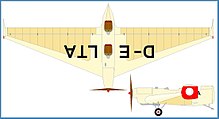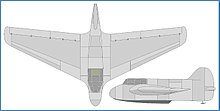Lippisch Delta
After Alexander Lippisch's tailless constructions had reached a certain maturity with the Storch V , he ventured into the next project. For the intended flying wing concept, the delta wing seemed more suitable because of the larger volume in the middle section. Lippisch's employees on the Delta-1 project included Hans Jacobs , Fritz Kraemer, Heinrich Voepel , Wilhelm Hubert and the Canadian Beverley Shenstone. The latter brought the formula published shortly before by Glauert into the team. With the help of Glauert's formula it was possible for the first time to calculate profile moments . In contrast to the “storks”, the wing of the Delta I was given a so-called pressure point fixed profile (S- flap ).
Delta I.
In 1930 the Delta I first appeared as a glider on the Wasserkuppe and was flown in by Günter Groenhoff . Its wingspan was 13.24 m and it was controlled via external ailerons, internal elevators and end disk rudders. In the glider version, the pilot was accommodated in such a way that the glazed arrowhead of the wing allowed a view to the front. The companion only had small windows on the underside of the wing and next to his seat. The aircraft was flown in by Robert Kronfeld in 1930, whereby the arrangement of the rudders turned out to be unfavorable. Nevertheless, Lippisch and the ocean aviator Hermann Köhl decided to convert it to a powered aircraft.
Delta I motorized
Günther Groenhoff was able to demonstrate the machine in Tempelhof in 1931 . A Bristol Cherub with 32 hp served as drive . The Delta I remained in Tempelhof, where Hermann Köhl made a few flights with her. Due to the unfavorable rudder arrangement and the weak 32 HP Bristol Cherub engine, the machine remained inadequate. A near-accident with the Delta I meant that Köhl withdrew as a financier and turned to the engineering school in Weimar to have a flying wing developed there.
Delta II
In the meantime, Lippisch built a small demonstration aircraft for Günter Groenhoff, which was called Delta II. This machine got a newly developed Ursinus flight engine with 24 HP. The control should now take place via Elevons . Due to problems with the new engine, it was not possible to get the Delta II to fly. At the 13th Rhön competition in 1932, Groenhoff died with the high-performance sailor “Fafnir” . That was a bitter setback because he was the only one who had the difficult-to-fly Delta I under control. In addition, the RRG now had to repay the funds made available by Köhl.
Delta III / IV
The twin-engine Delta IV or F3 "Wasp" aircraft, developed in a hurry for Fieseler in 1932, also turned out to be a catastrophic failure. As if that weren't enough, difficulties arose with the Delta III built by Focke-Wulf . In its original form, this resembled the Delta I. It was only after a total renovation carried out by F. Kraemer in Darmstadt that the Delta III was made airworthy. The external appearance of the new fuselage was now strongly reminiscent of the usual low - wing sport aircraft of that time. The Delta III received official approval and was frequently flown to by Erich Wiegmeyer, who is now acting as a test pilot . During a demonstration at the Siebel works in Halle, however, Wiegmeyer pulled over the Delta III when it started, and the machine was destroyed. In the meantime, the Delta IV / Fieseler F3 "Wasp" had been rebuilt. The rear engine and the duck slats have been left out. This machine, now called Delta IVb, was taken over and tested by Wiegmeyer. As if all the setbacks weren't enough, in 1935 Wiegmeyer got in the way of another aircraft landing and the machine was destroyed again. Wiegmeyer then left the DFS and the Lippisch group was left without an airplane or test pilot.
Delta IVc / DFS 39
The development of Delta aircraft was no longer supported by the authorities, and the end of Lippisch's flying wing developments seemed to have come. Then, however, the influential Prof. Walter Georgii stood up as an advocate and so the Delta IV was nominally rebuilt. In reality, this rebuilding was tantamount to a completely new construction. By working with Heini Dittmar , who was now acting as a test pilot, it gradually succeeded in mastering the problems of flying wing aerodynamics, and this gave the aircraft its final appearance. When the machine had overcome its teething troubles as DFS 39 , Lippisch's knowledge of tailless designs had grown considerably. Lippisch himself described the DFS 39 (and not the DFS 194 ) as the true predecessor of the Me 163 .
Delta V / DFS 40
The DFS 40 Delta V was a tailless test aircraft from the German Research Institute for Glider Flight (DFS). The aircraft was designed as a further development of the DFS 39 / Delta IVc. Lippisch and Dittmar went to Messerschmitt to build the Me 163 and Rudolf Opitz took over the testing, but crashed on a test flight. This ended the development of Delta aircraft at DFS. Opitz took on an important role in the testing of the DFS 230 and flew it on May 10, 1940 , but also switched to Lippisch's group at Messerschmitt.
DFS 194
The DFS 194 was originally planned as a test model for a fighter aircraft with a pusher propeller with a wing design very similar to the DFS 39 and DFS 40, and models were extensively tested in the wind tunnel. Then, however, the design was heavily modified in order to be able to use the machine as a test aircraft for the Me 163 .
literature
- Wolfgang Späte: The top secret Vogel Me 163. Your pilots, your designers, your missions. Verlag für Wehrwissenschaften, Munich 1983, ISBN 3-89555-142-2 .
- Stephen Ransom, Hans-Hermann Cammann: Me 163 Rocket Interceptor Volume 1. ISBN 1-903223-13-X .
- Alexander Lippisch, Fritz Trenkle : A triangle flies - The history of the Delta aircraft up to 1945. Motorbuch-Verlag, Stuttgart 1976, ISBN 3-87943-467-0 .
- Rudolf Storck among others: Flying Wings. The historical development of the world's tailless and flying wing aircraft. Bernard and Graefe, Bonn 2003, ISBN 3-7637-6242-6 .









